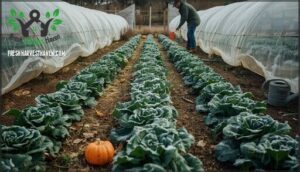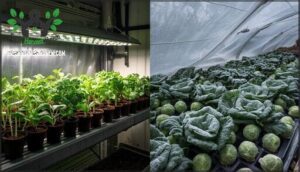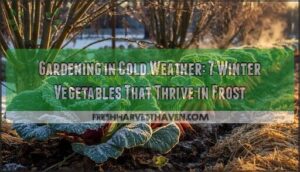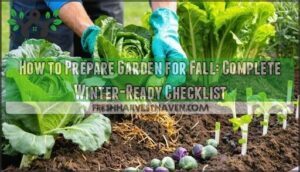This site is supported by our readers. We may earn a commission, at no cost to you, if you purchase through links.
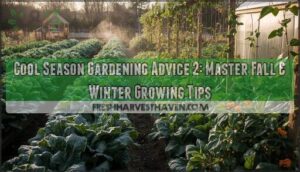
Focus on succession planting leafy greens like spinach and kale every 2-3 weeks, while using companion planting strategies—pair broccoli with rosemary and marigolds for natural pest control, or plant peas to boost soil nitrogen for neighboring carrots.
Monitor soil temperatures above 45°F for ideal planting timing, and extend your harvest season with row covers and cold frames.
Hardy varieties like ‘Bloomsdale’ spinach can survive temperatures as low as 10°F with proper protection.
Strategic microclimat management transforms winter gardening challenges into year-round growing opportunities.
Table Of Contents
- Key Takeaways
- Cool Season Crops
- Companion Planting Benefits
- Gardening Practices
- Caring for Cool Season Crops
- Indoor and Outdoor Growing Tips
- Frequently Asked Questions (FAQs)
- When should you plant cool-season crops?
- How do you care for a cold weather vegetable plant?
- Can vegetables grow in cold weather?
- What should I plant in a cold frame garden?
- When is the best time to plant a vegetable?
- When should you plant a plant?
- When should cool-season crops be planted?
- What vegetables grow best in cool weather?
- Which vegetables should not be planted next to each other?
- What temperature do cool-season crops grow best?
- Conclusion
Key Takeaways
- Monitor soil temperature above 45°F – You’ll get better germination and plant establishment when you track soil temps with a thermometer rather than relying on air temperature alone
- Use succession planting every 2-3 weeks – You’ll ensure continuous harvests of leafy greens like spinach and kale throughout the growing season instead of getting one large harvest
- Implement strategic companion planting – You’ll naturally control pests by pairing broccoli with rosemary and marigolds, or boost soil nitrogen by planting peas near heavy feeders like carrots
- Extend your season with frost protection – You’ll harvest fresh vegetables well into winter by using row covers and cold frames, with hardy varieties like ‘Bloomsdale’ spinach surviving down to 10°F
Cool Season Crops
Cool season crops are your garden’s cold-weather champions, thriving in temperatures below 70°F and actually improving in flavor after light frost exposure.
These hardy vegetables include leafy greens like spinach and kale, root vegetables such as carrots and parsnips, and brassicas like broccoli and cabbage that can withstand temperatures as low as 10-21°C while continuing to grow.
Characteristics of Cool Season Crops
Understanding cool season crops starts with recognizing their unique crop hardiness characteristics.
These frost tolerant vegetables thrive in temperatures between 40-70°F, making them perfect for cool climate gardening when warm-season plants struggle.
Cool season vegetables offer distinct advantages:
- Frost tolerance: Light frost actually sweetens flavors by converting starches to sugars
- Soil adaptation: These crops develop robust root systems in cooler conditions
- Growth patterns: They naturally resist bolting when temperatures drop
- Extended harvest: You’ll enjoy fresh produce when other gardens go dormant
Unlike their warm-weather cousins, coolseason crops use cooler temperatures as their sweet spot.
Their cellular structure adapts to handle temperature fluctuations, while their bolt resistant nature means they won’t rush to seed prematurely.
This natural resilience makes them your garden’s cold-weather champions.
Examples of Cool Season Crops
Beyond spinach and kale, cool season vegetables offer diverse crop selection options for fall planting.
Leafy greens like lettuce thrive in cooler conditions. Root vegetables including carrots, radishes, and parsnips develop sweetness after frost exposure.
Brassica varieties such as broccoli, cabbage, and Brussels sprouts handle cold weather beautifully. CoolSeason vegetables like peas fix nitrogen while providing harvests.
These cool season crops transform your garden into a productive winter wonderland, with diverse crop selection options and the ability to thrive in cooler conditions.
Temperature Requirements for Growth
Temperature management makes or breaks your cool season garden success. These crops flourish when soil temperature stays between 40°F and 70°F, with air quality remaining crisp and cool. Smart gardeners monitor thermal zones and work with chill hours to maximize yields.
Your frost date marks the starting line for fall plantings, while frost protection methods extend harvests well into winter. Cool season crops actually prefer temperatures below 70°F—they’ll bolt faster than you can say "spinach salad" when it gets too warm.
Here’s your temperature toolkit:
- Monitor soil temperature with a thermometer at 2-inch depth for accurate readings
- Calculate chill hours below 45°F to predict when plants will thrive
- Use thermal zones to identify microclimates in your garden space
- Apply frost tolerance knowledge—kale survives 20°F while lettuce needs protection at 32°F
- Time plantings 10-12 weeks before your average frost date for ideal cool season gardening
Understanding cool season gardening techniques is vital for a successful harvest. Master these basics and you’ll harvest fresh greens through winter.
Companion Planting Benefits
You’ll discover that strategic plant partnerships can transform your cool season garden into a pest-resistant, space-efficient powerhouse.
These companion combinations work together naturally, with some plants repelling harmful insects while others enrich the soil or maximize your growing space.
Broccoli Companion Combinations
Smart Broccoli Pairings transform your garden into a pest-fighting powerhouse. Plant aromatic herbs like rosemary and thyme around broccoli—their volatile oils naturally repel cabbage loopers and aphids. Companion planting with onions creates double protection, deterring both insects and hungry deer.
For Pest Deterrents, marigolds disrupt pest life cycles while nasturtiums act as clever trap crops, luring flea beetles away from your precious broccoli heads.
Space Maximization gets easier with fast-growing radishes tucked between broccoli rows. They’ll finish harvesting before your broccoli needs the room. Shallow-rooted lettuce works as living mulch, suppressing weeds while conserving soil moisture.
Growth Support comes from strategic Vegetable Synergy—plant nitrogen-fixing legumes nearby to enrich soil naturally. This Crop Diversity approach guarantees your cool season gardening delivers maximum Companion Benefits through thoughtful Garden Planning. By considering broccoli companion plants, you can create a balanced and thriving garden ecosystem.
Pea Companion Combinations
Pea nitrogen fixing transforms your garden into a powerhouse of soil enrichment. These legume superstars don’t just feed themselves—they create nutrient-rich environments that boost neighboring cool season crops substantially.
Legume superstars feed your garden twice—nourishing themselves while enriching soil for neighbors
Peas excel in companion cropping arrangements that maximize garden productivity:
- Carrots benefit tremendously from pea partnerships, showing 20% higher yields when grown together. The shade from pea support systems creates ideal growing conditions while nitrogen-rich soil feeds carrot development.
- Lettuce grows 15% faster near peas thanks to enhanced soil nitrogen levels. This companion planting combination delivers continuous harvests throughout cool seasons.
- Brussels sprouts and cabbage require 14-18% less synthetic fertilizer when paired with peas. Legume interactions naturally supply the nitrogen these heavy-feeding brassicas crave.
Your pea support systems do double duty—providing structure while creating microclimates that protect companion crops. These companion planting benefits make peas essential for successful cool season gardening, turning your garden beds into self-sustaining ecosystems. Understanding companion planting guide principles can help you create a more productive and diverse garden.
Onion Companion Combinations
When you’re planning your cool season garden, onions serve as nature’s bodyguards for your crops.
These pungent bulbs don’t just add flavor to your kitchen—they’re pest control powerhouses that boost your garden’s productivity.
Strategic onion pairings create a natural defense system that protects vulnerable crops while improving soil health and maximizing crop yields.
The sulfur compounds in onions repel common garden pests, making them ideal companions for delicate vegetables.
Here are proven onion companion combinations for your cool season gardening success:
- Carrots: Onions deter carrot flies while carrots loosen soil for onion bulb development
- Lettuce: Fast-growing lettuce fills spaces between onions while benefiting from pest protection
- Brassicas: Cabbage family crops thrive with onions’ natural pest-deterrent properties
- Spinach: This leafy green enjoys the pest-free environment onions create
- Radishes: Quick-maturing radishes break up soil compaction around onion roots
These companion planting benefits extend beyond pest management.
You’ll notice improved nutrient cycling, better space utilization, and stronger overall garden planning strategies when you incorporate these partnerships into your cool season crops rotation.
Kale Companion Combinations
Your kale garden becomes a powerhouse when you pair it with the right Companion Crops. Kale Pairings work like a neighborhood watch system—each plant has your kale’s back.
Marigold Benefits include natural pest control, while their bright blooms attract beneficial insects that keep aphids away. Cilantro Effects go beyond flavor enhancement—this herb actually improves kale’s growth and deters harmful pests through its strong scent.
Radish Companions maximize space efficiency since they mature quickly, leaving room for your kale to spread. These cool season crops create a living mulch that retains soil moisture.
Here’s your winning combination:
This companion planting strategy transforms your garden into a self-supporting ecosystem where every plant contributes to Cool Season Gardening Tips success.
Gardening Practices
Success in cool season gardening hinges on proper timing and smart preparation techniques. You’ll maximize your harvest by understanding soil temperature patterns and implementing strategic crop rotation practices.
Planting Preparation and Timing
Perfect timing makes all the difference in cool season gardening success.
Your soil preparation starts with checking soil temperature using a thermometer—aim for consistent readings above 45°F before planting.
Here’s your roadmap:
- Monitor frost dates in your area and plan planting schedules around them
- Prepare garden soil by clearing debris and mixing in aged compost for nutrient-rich beds
- Select timing strategies that match seed packets’ recommendations with your local climate
Start seeds indoors under grow lights, then gradually harden them off outdoors over seven days.
Row covers protect against unexpected temperature drops while you’re establishing your cool season crops.
Accurate soil temperature readings are vital for determining the ideal soil thermometer usage to promote healthy plant growth.
Garden Planning and Crop Rotation
Smart garden planning starts with understanding your growing space and seasonal rhythms. Once you’ve prepared your soil, creating a strategic layout becomes your foundation for success.
Crop rotation disrupts disease cycles and prevents soil depletion. Move plant families to different beds each year—keep brassicas, legumes, and nightshades separated by at least three years. This simple practice cuts disease incidence by up to 90% while boosting yields.
Garden maps help you track which crops grew where. Use graph paper or apps to document your seasonal cycles and planting time for each bed.
- Soil testing reveals pH levels and nutrient needs before each growing season
Effective crop rotation plans can be developed by considering the specific needs of different plant families. Record harvest scheduling patterns to optimize future Cool Season Gardening efforts and confirm continuous production throughout fall and winter months.
Planting Cool Season Crops
Your garden’s success depends on mastering seed selection and timing. Choose varieties suited for your frost dates – cold-hardy cultivars handle temperature drops better.
For cool season crop selection, direct sow root vegetables like carrots and parsnips in late summer. Their sugars concentrate as soil temperatures drop. Leafy greens thrive when soil stays above 45°F.
| Planting Method | Best Cool Season Crops |
|---|---|
| Direct Sowing | Spinach, lettuce, radishes, peas |
| Transplanting | Broccoli, cabbage, kale |
Start brassicas indoors 6-8 weeks before your first frost. This gives transplants time to establish strong roots.
Crop spacing matters – overcrowded plants compete for nutrients and air circulation. Follow seed packet guidelines religiously.
Soil preparation includes loosening compacted earth and adding compost. Cool season gardening rewards patience with proper frost timing – plant too early and seeds won’t germinate.
Preparing The Garden for Cool Season Crops
Beyond just planting seeds, successful cool season gardening starts with thorough soil preparation and strategic planning. Begin by testing soil temperature at 2-inch depth—aim for workable, crumbly texture rather than sticky mud that’ll compact under pressure.
Your garden soil preparation sets the foundation for thriving cool season crops throughout fall and winter months.
Here’s your essential preparation checklist:
- Soil Preparation: Test pH levels and add lime if needed for ideal nutrient uptake
- Garden Layout: Map companion plantings and spacing requirements for efficient bed maintenance
- Crop Scheduling: Plan succession plantings based on local frost dates and maturity times
- Frost Protection: Install cold frames, row covers, or hoop tunnels before temperatures drop
- Crop Rotation Techniques: Rotate plant families to prevent soil depletion and disease buildup
Accurate soil analysis is vital, and using a soil test kit helps determine the perfect balance of nutrients.
This methodical approach to preparing soil for fall helps your cool season crops get the best possible start for productive harvests.
Caring for Cool Season Crops
Once you’ve planted your cool season crops, proper care becomes essential for maximizing their growth potential and harvest quality.
Understanding temperature requirements, season extension techniques, frost protection methods, and variety selection will guarantee your vegetables thrive throughout the cooler months, ensuring they reach their full growth potential.
Soil and Air Temperature Requirements
Temperature monitoring forms the foundation of successful cool season gardening. Your soil thermometer should read between 40-65°F for ideal germination, while air temperature stays below 70°F. These thermal zones create the sweet spot where cool-season crops flourish.
Cool season crops thrive when soil temperatures hit that perfect 40-65°F sweet spot—your garden’s cold-weather championship zone
Garden soil preparation with compost helps regulate temperature fluctuations in well-drained soil. Climate monitoring prevents costly mistakes—one day of unexpected heat can trigger premature bolting in your carefully tended crops.
| Temperature Factor | Optimal Range |
|---|---|
| Soil for Germination | 40-65°F |
| Air Temperature | Below 70°F |
| Frost tolerance protection | 28-32°F range |
Soil warming techniques like black plastic mulch raise temperatures by 2-5°C in raised beds. Gardening practices for cool weather include checking microclimates—sunny spots heat faster than shaded areas. Understanding these temperature requirements keeps your cool season crops healthy and productive through fall and winter growing seasons.
Extending The Growing Season
Your cool season crops don’t have to surrender when temperatures drop. Season extension techniques can add weeks to your harvest window, keeping fresh vegetables coming even when neighbors’ gardens have gone dormant.
These three methods will transform your winter gardening success:
- Cold frames create protective microclimates that raise temperatures by 10-20°F, allowing tender greens to thrive through light frosts
- Row covers provide 4-6°F of frost protection while transmitting 70-85% of available sunlight for continued photosynthesis
- High tunnels extend your growing season by 2-4 weeks in both directions, effectively shifting your hardiness zone warmer
Layer these frost protection methods for maximum impact. Row covers inside cold frames add another 2-3 weeks of growing time per layer. This stacking approach lets you harvest spinach, kale, and lettuce well into December in most climates.
Smart placement matters too. Position structures in south-facing locations with wind protection to maximize solar gain and minimize heat loss.
Protecting Cool Season Plants From Frost
Frost protection methods become your garden’s insurance policy when temperatures drop unexpectedly. Smart gardeners use multiple strategies to shield their crops from freezing damage.
Here’s your frost protection toolkit:
- Row covers: Lightweight fabric blankets that trap soil warmth while allowing airflow, preventing plant burns
- Cold frames: DIY mini-greenhouses using old windows that boost temperatures by several degrees around plants
- Mulch application: Layer 3+ inches of straw or leaves around plant bases to insulate root systems
- Water-filled containers: Place jugs near crops to absorb daytime heat and release it during cold nights
- Strategic watering: Moist soil releases heat slower than dry soil, providing natural frost protection
Understanding frost damage risks is essential for effective protection.
Extending growing season requires timing these methods before frost hits. Monitor weather forecasts and prepare protection when temperatures threaten to dip below your crops’ tolerance levels.
Choosing Bolt-Resistant Varieties
Smart Seed Selection prevents bolting headaches before they start.
Choose Bolt Resistance varieties like ‘Salad Bowl’ lettuce or ‘Bloomsdale’ spinach that handle temperature swings gracefully.
| Crop | Bolt-Resistant Variety | Frost Tolerance |
|---|---|---|
| Lettuce | Salad Bowl, Red Sails | Light frost hardy |
| Spinach | Bloomsdale, Space | Heavy frost tolerant |
| Kale | Winterbor, Red Russian | Extremely hardy |
Variety Trials from local extensions reveal top performers for your zone’s Cool Crop Breeding successes.
Indoor and Outdoor Growing Tips
You’ll discover that cool season crops offer unique advantages whether grown indoors under lights or outside in chilly conditions.
The key lies in understanding each plant’s cold tolerance levels and timing your shifts between growing environments perfectly.
Growing Vegetables Indoors
Bringing your cool season vegetables indoors opens up year-round growing possibilities that outdoor gardeners can only dream of. Container gardening with proper indoor lighting transforms any space into a productive mini-farm.
Your indoor setup requires these key components:
- Full-spectrum LED grow lights positioned 2-4 inches above plants, providing 12-16 hours of daily illumination for ideal photosynthesis
- Well-draining soil mixtures combining organic potting soil with compost and perlite for superior root development
- Climate control systems maintaining 65-75°F temperatures with 50-60% humidity levels for consistent growth
- Balanced fertilizer applications every two weeks to support nutrient uptake in container environments
Cool season crops like spinach, kale, and lettuce thrive indoors with minimal fuss. Hydroponic systems can dramatically increase yields, while cold frames extend your growing season. Monitor soil moisture daily—overwatering kills more plants than drought. Your indoor garden becomes a reliable source of fresh vegetables regardless of weather conditions outside.
For ideal growth, understanding LED grow lights is vital for indoor gardening success.
Gardening Tips for Cool Weather
While indoor growing sets the foundation for year-round harvests, outdoor cool season vegetable gardening offers unique rewards when you master the right techniques.
Your garden tools become your best allies during cooler weather—keep row covers, mulch, and thermometers within arm’s reach.
Soil preparation starts weeks before planting.
Work compost into beds and use black plastic mulch to boost soil temperature by 2-5°C.
This simple trick helps cool season crops establish stronger root systems.
Crop monitoring becomes critical as temperatures drop.
Check forecasts regularly and have frost protection ready—water-filled jugs or floating row covers work wonders.
Understanding cool season gardening is key to a successful harvest.
Here’s your quick reference:
Winter harvesting rewards patience with sweeter vegetables and extended growing seasons through smart garden management.
Cold Hardiness of Vegetables
Cold hardiness transforms your garden into a winter wonderland where vegetables actually improve with freeze damage – or rather, lack thereof. Hardy varieties develop natural antifreeze through sugar concentration, making carrots taste like candy after chill hours below freezing.
Cool season crops with textured leaves outperform smooth varieties in frost tolerance. Your winter harvest depends on understanding these temperature thresholds and using cold frames plus row covers for protecting plants from frost.
Here’s your cold-weather arsenal:
- Very hardy crops (kale, spinach, parsnips) survive 0-10°F
- Frost-tolerant vegetables handle 26-32°F with proper acclimation
- Root crops benefit from soil insulation and mulching
- Savoy-leaf varieties show superior cold resilience
- Mature plants resist freezing better than young seedlings
Transitioning From Cool to Warm Seasons
Understanding plant behavior across changing seasons helps you maximize harvests year-round.
When cool season vegetables start showing stress from rising temperatures, it’s your cue to begin warm weather preparation.
Here’s your seasonal crop shift strategy:
- Start warm-season seeds indoors 6-8 weeks before last frost for transplant readiness
- Monitor soil temperature management – use mulch to moderate heat for sensitive cool season crops
- Install row covers to protect shifting plants from temperature fluctuations
- Practice succession planting every 2-3 weeks for continuous cool season vegetables harvest
- Time final cool-season plantings before bolt-resistant varieties fail in warming conditions
Climate change impact means earlier shifts, so watch soil thermometers rather than calendar dates for extending the growing season.
Frequently Asked Questions (FAQs)
When should you plant cool-season crops?
Plant cool-season crops 2-4 weeks before your last spring frost or 10-12 weeks before your first fall frost.
They’ll thrive in 40-70°F temperatures and actually taste sweeter after light frost.
How do you care for a cold weather vegetable plant?
Absolutely extraordinary care transforms your cold-weather vegetables into winter warriors.
Monitor soil temperatures between 40-70°F, use row covers for frost protection, maintain consistent moisture.
Harvest before ground freezes for maximum sweetness.
Can vegetables grow in cold weather?
Yes, you can grow vegetables in cold weather! Cool-season crops like kale, spinach, carrots, and broccoli thrive in temperatures below 70°F and tolerate light frost beautifully.
What should I plant in a cold frame garden?
Cold frames create microclimates perfect for kale, spinach, carrots, and lettuce. You’ll extend seasons while protecting crops from harsh winds. Plant bolt-resistant varieties and monitor soil temperature.
When is the best time to plant a vegetable?
Timing depends on your crop and local climate.
For cool-season vegetables, plant in early spring when soil reaches 40-50°F or late summer for fall harvest.
Check your area’s last frost date and soil temperature first.
When should you plant a plant?
Like planting seeds in your garden of dreams, you’ll plant when soil temperature hits 40-70°F and frost dates align. Cool-season crops thrive in early spring or fall timing.
When should cool-season crops be planted?
You’ll want to plant cool-season crops in early spring after soil warms above 40°F or in late summer for fall harvests, timing plantings around your local frost dates.
What vegetables grow best in cool weather?
Root vegetables like carrots and parsnips develop 40% more sugar when exposed to frost, making cool weather perfect for growing leafy greens, brassicas, and root crops that thrive below 70°F.
Which vegetables should not be planted next to each other?
You shouldn’t plant brassicas like broccoli and cabbage together—they compete for nutrients and attract similar pests.
Avoid planting onions near peas, as onions can inhibit pea growth and nitrogen fixation.
What temperature do cool-season crops grow best?
Hit the sweet spot with cool-season crops at 40-70°F (4-21°C). They’ll thrive in these chilly temperatures, tolerating light frost while warmer weather makes them bolt prematurely.
Conclusion
Research shows that cool season vegetables can produce 40% more nutrients when grown in temperatures below 65°F compared to warm season conditions.
You’ve now got the essential cool season gardening advice 2 strategies to transform your fall and winter growing success.
From succession planting leafy greens to strategic companion combinations and frost protection techniques, these methods extend your harvest season substantially.
Monitor soil temperatures, utilize row covers, and select hardy varieties to maximize yields year-round.



